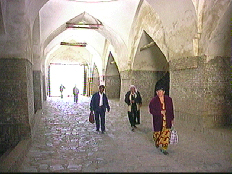 Inside the Palvan Darvasa
Inside the Palvan DarvasaIt was outside the Palvan Gate and next to the bazaar that public proclamations and decrees were made and executions carried out, until the square beside the Kunya Ark became the preferred spot for such activities. However, the gate continued in its importance as the centre for Khiva's infamous slave market throughout the nineteenth century. Persians, Kurds and Russians were dragged, bound and often in a terrible condition, across the Karakum desert by their Turkoman captors. Neither women nor children were spared and those who survived were sold here at the bazaar. Young Russian men were eagerly sought after and reached prices as high as four camels. Of the women, Persians were considered the most desirable addition to a harem.
'Alas!' wrote Captain Abbot in 1840 during his attempt to liberate the slaves, 'He who enters Khiva abandons all hope, as surely as he who enters into hell. His prison house is girdled with trackless deserts, whose sole inhabitants are the sellers of human flesh.' Russian visitors, such as General Muraviev, witnessed the sorry state of some of his own countrymen, who begged him to pray for them and obtain their release. Some attempted to escape but were usually caught. Punishment for an escaped slave proved a dilemma for the owner, who wished to teach him a lesson without causing too much physical harm and reducing his work capacity. A solution was found - the slave would be nailed by the ear to the Palvan Darvasa gate for a couple of days of pain, humiliation and exposure to the elements before returning to a life of drudgery and servitude.








